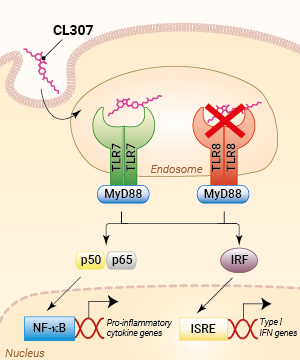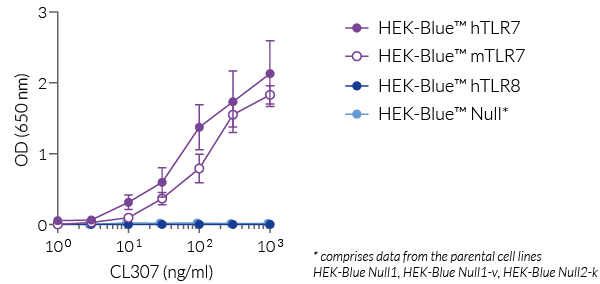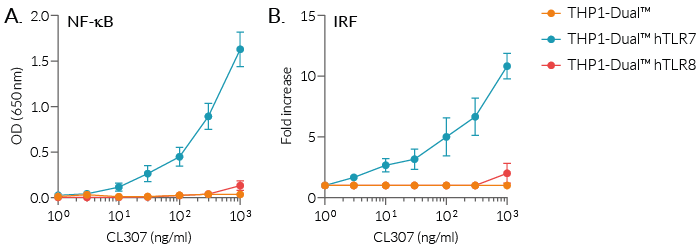CL307
| Product | Unit size | Cat. code | Docs. | Qty. | Price | |
|---|---|---|---|---|---|---|
|
CL307 TLR7 Agonist - Base analog |
Show product |
500 µg |
tlrl-c307
|
|
TLR7 Agonist - Base analog

TLR7/TLR8 activation with CL307
 InvivoGen also offers:
InvivoGen also offers:
• TLR reporter cells: HEK293, RAW, THP-1 cells
• TLR research tools: Antibodies, Inhibitors, etc.
CL307 is a potent and specific Toll-like receptor 7 (TLR7) agonist. It was generated by covalently linking spermine to the adenine analog CL264, a TLR7 agonist developed by InvivoGen. Coupling with spermine enhances cellular uptake by endocytosis [1, 2] and the subsequent delivery to TLR7. Importantly, CL307 does not stimulate TLR8. TLR7 and TLR8 are endosomal pattern recognition receptors that play an important role in the antiviral immune response [3].
Using our HEK-Blue™ reporter cell lines expressing human or mouse TLR7 or TLR8, we demonstrated that CL307 induces robust NF-κB activation at concentrations as low as 20 nM (10 ng/ml). CL307 is a TLR7-specific ligand that does not activate TLR8 even at high concentrations (>10 µg/ml) (see figures). Moreover, CL307 is able to activate hTLR7-dependent NF-κB and IRF pathways, as assessed using our monocytic THP1-Dual™ reporter cell lines expressing two reporter genes for SEAP and Lucia luciferase as well as hTLR7 or hTLR8 (see figure). It has been reported in the literature that CL307 induces the production of the pro‑inflammatory cytokine, interleukin 6 (IL-6) in peripheral blood mononuclear cells [1].
Key Features of CL307
- Potent and specific activator of human & murine TLR7
- Does not activate TLR8
- Each lot of CL307 is highly pure (≥95%) and functionally tested
![]() Read our review about TLR7 and TLR8.
Read our review about TLR7 and TLR8.
References:
1. Järver P. et al., 2018. Single-stranded nucleic acids regulate TLR3/4/7 activation through interference with Clathrin-mediated endocytosis. Sci Rep. 8(1):15841.
2. Soulet D. et al., 2002. Role of endocytosis in the internalization of spermidine-C(2)-BODIPY, a highly fluorescent probe of polyamine transport. Biochem. J. 367:347-57.
3. Georg P. & Sander L.E., 2019. . Innate sensors that regulate vaccine responses. Curr. Op. Immunol. 59:31.
Specifications
Specificity: human/mouse TLR7 agonist
Synonym: N1-glycinyl [4-((6-amino-2- (butylamino)-8- hydroxy-9H- purin- 9-yl)methyl) benzoyl] spermine
Working concentration: 5 ng- 1 µg/ml (~10nM - 2 µM)
Formula: C29H47N11O3
Molecular weight: 597 g/mol
Solubility: 2 mg/ml in water
Quality control:
- Purity: ≥95% (UHPLC)
- The biological activity of CL307 has been validated using cellular assays.
- The absence of bacterial contamination (e.g. lipoproteins and endotoxins) has been confirmed using HEK-Blue™ hTLR2 and HEK-Blue™ hTLR4 cells.
Contents
- 500 µg CL307
- 1.5 ml sterile endotoxin-free water
![]() Products are shipped at room temperature
Products are shipped at room temperature
![]() Stored at -20°C.
Stored at -20°C.
Details
TLR7 and TLR8:
TLR7 and TLR8 are endosomal pattern recognition receptors that share structural homology [1]. Both receptors are activated by single-stranded RNA (ssRNA) molecules, however, they exhibit different ligand-binding specificities and cellular expression patterns suggesting that they have nonredundant specialized roles.
TLR7 is essentially expressed by plasmacytoid dendritic cells (pDCs) but is also found in B cells and other myeloid cells [2] while TLR8 is highly expressed by myeloid cells and is absent from pDCs and B cells [2].
The endosomal distribution of TLR7 and TLR8 allows them to scan for the presence of microbial RNA in the phagocytic cargo. Their activation leads to NF-κB-, AP1-, and interferon regulatory factor (IRF)-mediated production of type I interferons (IFN-α/β) and pro-inflammatory cytokines [2].
Structural analyses have revealed that both TLR7 and TLR8 possess two binding sites (designated as Site 1 and Site 2) which do not share the same specificities.
Site 1 is highly conserved between TLR7 and TLR8 and binds nucleosides (guanosine (G) for TLR7 and uridine (U) for TLR8) or base analogs. The ligand preference for TLR7 and TLR8 is thus explained by the presence of specific residues in Site 1. Site 1 occupancy allows receptor dimerization and signaling.
Site 2 is less conserved and binds ssRNA with U(U) and U(G) motifs, respectively [3, 4]. Of note, ssRNA-binding to Site 2 is not sufficient for the formation of a signaling-competent TLR dimer but it strongly enhances the binding affinity of Site 1 [3, 4]. Thus, TLR7 and TLR8 appear to sense distinct RNA-degradation products rather than full-length ssRNAs [4].
1. Chuang T.H. & Ulevitch R.J., 2000. Cloning and characterization of a sub-family of human toll-like receptors: hTLR7, hTLR8, and hTLR9. Eur Cytokine Netw, 11:372-8.
2. Georg P. & Sander L.E., 2019. Innate sensors that regulate vaccine responses. Curr. Op. Immunol. 59:31.
3. Zhang Z. et al., 2018. Structural analyses of Toll-like receptor 7 reveal detailed RNA sequence specificity and recognition mechanism of agonistic ligands. Cell Rep. 25:3371.
4. Tanji H. et al., 2015. Toll-like receptor 8 senses degradation products of single-stranded RNA. Nat. Struct. Mol. Biol. 22:109.
Chemical structure of CL307









